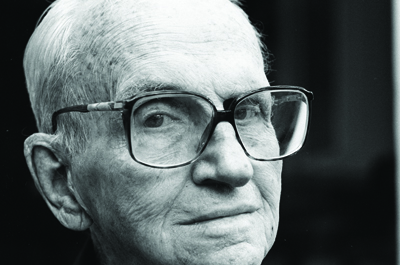Of Fame and Fortune
The literary legacy of James A. Michener ’29 has an enduring impact on the College

James A. Michener ’29 in Austin, Texas, 1994, three years before his death. Photo by Robert Vavra. Archival Services, James A. Michener Library, University of Northern Colorado, Greeley, Colo.
Many writers hope their works achieve immortality. James A. Michener ’29 is one writer for whom thatundefined outcome seems assured—through his Pulitzer Prize-winning short story collection Tales of the South Pacific, the inspiration for the hit Broadway musical and Oscar-winning film South Pacific.
Through its storyline, South Pacific keeps Michener’s progressive views on racial relations alive and at the same time adds to Swarthmore’s bottom line every time, everywhere, it is staged.
Let’s say the singing sensations at Brookville High School in Brookville, Ohio, want to warble “Some Enchanted Evening,” “Bali Hai,” or another South Pacific showstopper for their spring musical. Swarthmore would get around $60 for two performances as the share of royalties paid to all the royalty participants in the musical, which include Rogers and Hammerstein. Then, multiply such performances county by county, state by state, country by country, and the result is that in the last decade, the College has garnered more than $1.7 million from South Pacific royalties. The bulk came from the 2008 Broadway revival of the musical, according to Robert Freedman ’58, the son of Michener’s original stage-play agent and current agent for Michener’s interest in the royalties from South Pacific.

A poster from South Pacific the movie starring Rosanno Brazzi and Mitzi Gaynor.
Michener’s enduring works have brought Swarthmore substantial support. The current market value of all the Michener endowment funds is more than $35 million, according to Suzanne Welsh, vice president for finance and treasurer. At present, those funds help support the implementation of the College’s strategic plan, she says.
Michener, well known for his philanthropy as well as his writing, gave more than $100 million to schools and libraries, but he gave most generously to Swarthmore. When he died in 1997, he left the College the bulk of his estate—$10 million—as well as the copyrights and royalty rights to his 43 books.
Royalties flow to the College through two methods, Welsh explains. Works represented by WME (formerly the William Morris literary agency) are owned by Marjay Corp., a company that Michener established to handle his works and which he bequeathed to the College. Robert A. Freedman Dramatic Agency represents other works, including the lucrative South Pacific.
For a college to benefit so substantially from a deceased author, says Eric Lupfer, the Michener estate’s WME literary agent, is a “relatively rare thing, especially to the extent that Michener took his commitment to Swarthmore. I recall Owen Laster, his late literary agent, telling me that Swarthmore’s investment in Michener for his education so profoundly affected Michener and changed his life that he felt an enduring love for the College—he felt so blessed by it. And therefore he really wanted to leave something substantial for it out of gratitude.”
James Magnuson, director of the James A. Michener Center for Writers at the University of Texas at Austin, offers some additional insight into Michener’s generosity to Swarthmore. He knew the writer during the final decade of his life, when Michener lived in Austin. “He loved Swarthmore and talked about how transformative the experience was,” Magnuson recalls. “He was an orphan from small-town Pennsylvania who was really poor. He had a scholarship and excelled as a student and athlete.”
Michener was one of the first Swarthmore students to graduate with highest honors in English, and that training enriched his meticulously researched fiction.
While the royalties continue to provide the College a steady income stream, there are other tangible results of Michener’s well-planned generosity. Two associate professorships, four scholarships named for his Japanese-American wife Mari, two seminars, and a fund for faculty leaves are among the concrete benefits.
Richard Eldridge, the 2009–10 James A. Michener Faculty Fellowship recipient, spent an entire academic year at the Freiburg Research Institute for Advanced Studies at the University of Freiburg in Freiburg, Germany. Eldridge, the Charles and Harriett Cox McDowell Professor of Philosophy, says “It was, for me, a magical and wonderful year. It continues to inform my research, my teaching, my imagination, and my intellectual and personal life.”
Another distinctive legacy Michener left the College was the result of an earlier gift. In 1970, he provided the funds to transform Robinson House, a former faculty residence/dorm, into the Black Cultural Center.
Maurice Eldridge ’61, vice president for college and community relations and executive assistant to the president, recalls a letter Michener wrote to the College in 1969, during a period of racial unrest, saying, “ ‘If Swarthmore can’t solve this problem, no one can.’ He was instrumental in reconciling issues” on campus.
What Swarthmore continues to achieve through Michener’s generosity attests to “the intergenerational effects of gift planning,” adds Eldridge. “The benefit extends across past and future generations and, of course, to the current generation. It shows what can flow from this kind of giving—the power to sustain and shape the College while the endowment itself continues to grow. That gives the College flexibility.”
As a board member of Marjay Corp., Eldridge is eager to see new venues through which Michener’s literary legacy can prosper. He notes that not many of Michener’s books are in electronic format. “We’d like to take advantage of the evolution in media,” he says. “E-books would bring Michener into the modern world.”

James A. Michener ’29 strolls through Roncesvalles, in the Pyrenees, northeast of Pamplona, 1966. Photo by Robert Vavra.
Literary agent Lupfer affirms the works are heading in the e-direction: “We are aggressively looking to expand Michener’s digital footprint in e-books and audio books, and we’re also working with his publisher, Random House, to reboot the list and give it a fresh life and look. Additionally, through our LA office, we look to set the estate up with the right potential partners to bring his books to new life in TV and film.”
Some of the best known and most popular Michener titles today, Lupfer says, are Hawaii, The Covenant, Centennial, and, of course, Tales of the South Pacific. And the interest is not just stateside. “He’s long been widely published in Europe, but in the last couple of years we’ve seen increased interest in his titles from places like Brazil and China,” says Lupfer.
While e-books and new productions will keep the Michener name in the public eye—and funds flowing to the College—a novel due out in January may also attract fans of the late author. Michener Center director Magnuson has based the main character in Famous Writers I Have Known on Michener. “In the book, Michener is a literary god who has written 50 books and has millions of readers but is not critically acclaimed,” he says.
Today, Magnuson says, Michener is regarded by critics as a middlebrow author and “is undervalued as an important cultural figure. Tales of the South Pacific was a rather important book. He was quite an amazing man.
“He was complicated and staunchly moral and, being an orphan, he wanted to do good and do the right thing by people,” Magnuson says. In the legacy he left to Swarthmore, he surely meets those aims. g
To read what Michener wrote about his Swarthmore experience, click here.
 Email This Page
Email This Page